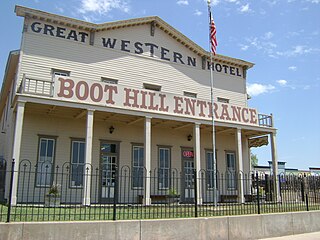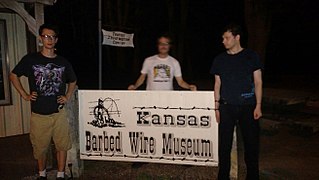 W
WBoot Hill Museum is an American historical museum located in Dodge City, Kansas.
 W
WBooth Western Art Museum, located in Cartersville, Georgia, is a museum dedicated to the Western United States; the only museum of its kind in the Southeastern United States. The Booth opened its doors in August 2003 with 80,000 square feet (7,400 m2) of contemporary art, illustration, movie posters, Civil War art, Indigenous Art and depiction, Presidential portraits and letters, authentic stagecoaches, and an interactive hands-on gallery for children based on a working ranch. A 40,000-square-foot (3,700 m2) expansion, complete in October 2009, doubled the Museum’s exhibition space allowing for even more Western artwork to be displayed. Now at 120,000 square feet (11,000 m2), Booth Museum is the second largest art museum in Georgia, and houses the largest permanent exhibition space for Western art in the country, with examples of early Western artists such as George Caitlin, Albert Bierstadt, Frederic Remington, Charles Russell, and others. However, the core of the collection is built around living masters of traditional Western imagery such as Howard Terpning, Ken Riley, and G. Harvey, as well as more contemporary artists like Ed Mell, Thom Ross, Donna Howell-Sickles, Kim Wiggins and others.
 W
WEgholm is a manor house and estate situated on the Hornsherred Peninsula, between Kirke Hyllinge and Skibby, in Lejre Municipality, some 60 km west of Copenhagen, Denmark. The Neoclassical main building from 1824, a gatehouse from 1870, a barn from 1880, a stable from circa 1890 and a former horse mill were listed on the Danish registry of protected buildings and places in 1998. Another building is now operated as an arms museum under the name Egholm Museum. The estate covers 770 hectares of land.
 W
WThe Eiteljorg Museum of American Indians and Western Art is located in downtown Indianapolis, Indiana, and houses an extensive collection of visual arts by indigenous peoples of the Americas, as well as Western American paintings and sculptures collected by businessman and philanthropist Harrison Eiteljorg (1903–1997). The museum houses one of the finest collections of Native contemporary art in the world.
 W
WFort Owen State Park is a historic preservation area owned by the state of Montana in the United States, located on the northern outskirts of the town of Stevensville, Montana. The park is named for Fort Owen, a mission and later trading post established in 1841 and named for trader John Owen. The park is one acre (0.40 ha) in size, 3,293 feet (1,004 m) in elevation, and is owned and managed by the Montana Department of Fish, Wildlife and Parks. Fort Owen is known as the "cradle of Montana civilization".
 W
WFort Whoop-Up was the nickname given to a whisky trading post, originally Fort Hamilton, near what is now Lethbridge, Alberta. During the late 19th century, the post served as a centre for trading activities, including the illegal whisky trade. The sale of whisky was outlawed but, due to the lack of law enforcement in the region prior to 1874, many whisky traders had settled in the area and taken to charging unusually high prices for their goods.
 W
WThe C. N. James Cabin is a frontier-style log cabin, originally used as both a store and home, constructed in 1868. It was later also used as a church. It stands in what is now Augusta, Kansas, United States. The builder and proprietor of the store was Chester N. James, a merchant who moved to the area to establish a trading post. James was a central figure in the organization of Augusta Township and eventually the incorporation of Augusta itself. Augusta is named for James' wife. The C. N. James Cabin was added to the National Register of Historic Places in 1994. It has been restored to its original appearance and is now the part of the Augusta Historical Museum, which is operated by the Augusta Historical Society.
 W
WThe Kansas Barbed Wire Museum is a barbed wire museum located in La Crosse, Kansas, United States, known as the “Barbed Wire Capital of the World.” The museum focuses on barbed wire and its history, displaying over 2,000 different forms of the wire and its history. Barbed wire played a significant role in the history of the settlement of the United States and forever changed the face of the prairie.
 W
WOld Cowtown Museum is an accredited history museum located in Wichita, Kansas, United States. It is located next to the Arkansas River in central Wichita. The Museum was established in 1952, and is one of the oldest open-air history museums in central United States with 54 historic and re-created buildings, including a period farm and out-buildings, situated on 23 acres of land off the original Chisholm Trail. Cowtown is a combination of attraction, museum, living history site, and historic preservation project. It is a 501(c)(3) not-for-profit institution.
 W
WThe Patee House, also known as Patee House Museum, was completed in 1858 as a 140-room luxury hotel at 12th Street and Penn in St. Joseph, Missouri. It was one of the best-known hotels west of the Mississippi River.
 W
WThe Pawnee Bill Ranch, also known as the Blue Hawk Peak Ranch, was the home of Wild West show entertainer, Gordon W. "Pawnee Bill" Lillie. Located in Pawnee, Oklahoma, it is owned and operated by the Oklahoma Historical Society. The Pawnee Bill Ranch consists of 500 of the original 2000 acres, original outbuildings, a fully furnished historic home, a modern museum, and a herd of bison, Longhorn cattle, and horses.
 W
WThe Pony Express Museum is a transport museum in Saint Joseph, Missouri, documenting the history of the Pony Express, the first fast mail line across the North American continent from the Missouri River to the Pacific coast. The museum is housed in a surviving portion of the Pike's Peak Stables, from which westward-bound Pony Express riders set out on their journey.
 W
WThe Historic St. Mary's Mission is a mission established by the Society of Jesus of the Catholic Church, located now on Fourth Street in modern-day Stevensville, Montana. Founded in 1841 and designed as an ongoing village for Catholic Salish Indians, St. Mary's was the first permanent settlement made by non-indigenous peoples in what became the state of Montana. The mission structure was rebuilt in 1866. It was listed on the National Register of Historic Places in 1970.
 W
WThe Sid Richardson Museum is open for visits. Make your free reservations here: https://sidrichardsonmuseum.org/visit/reservations/
 W
WThe Wells Fargo History Museum is a museum operated by Wells Fargo in its Corporate Headquarters in San Francisco, California that feature exhibits about the company's history. Some of the museums' displays include original stagecoaches, photographs, gold nuggets and mining artifacts, the Pony Express, telegraphs and historic bank artifacts. The museum was initially known as the Wells Fargo History Room when it opened in 1927 in San Francisco. In 1935 a museum was formed opened for public tours. The museum has been operating for nearly 60 years in its current location.